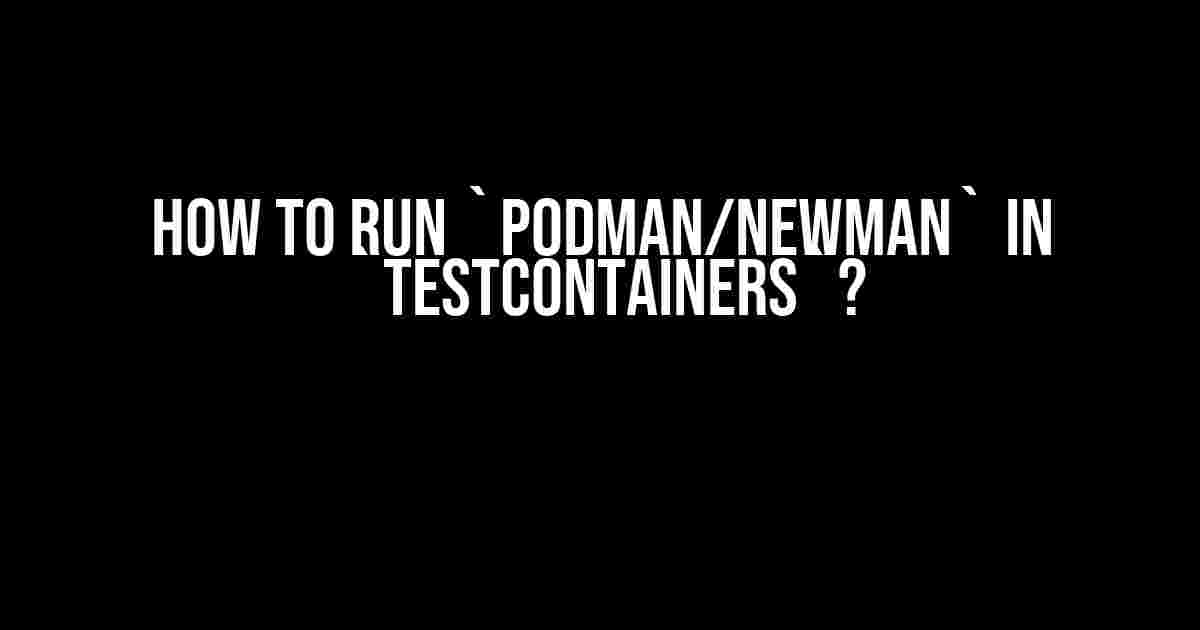Are you struggling to integrate `podman/newman` with `testcontainers`? Do you want to take your automated testing to the next level by leveraging the power of containerization? Look no further! In this comprehensive guide, we’ll walk you through the step-by-step process of running `podman/newman` in `testcontainers`.
Prerequisites
Before we dive in, make sure you have the following tools installed on your system:
podman(or Docker) for containerizationnewmanfor running Postman collectionstestcontainersfor container-based testing
What is `podman/newman`?
`podman` and `Docker` are two popular containerization platforms that allow you to package, ship, and run applications in containers. `newman` is a command-line collection runner for Postman that allows you to run and test your API collections programmatically.
In the context of `testcontainers`, we’ll use `podman` as a container runtime to spin up `newman` containers and execute our Postman collections.
What is `testcontainers`?
`testcontainers` is a Java testing library that provides a simple way to create and manage containers for testing purposes. It supports various container runtimes, including `Docker` and `podman`, allowing you to write more efficient and reliable tests.
Why Use `testcontainers` with `podman/newman`?
By combining `testcontainers` with `podman/newman`, you can:
- Isolate your tests and prevent interference from other tests or systems
- Ensure consistent and reproducible test results
- Simplify your testing infrastructure and reduce maintenance costs
- Write more efficient and reliable tests with less overhead
Step 1: Create a `testcontainers` Test Class
Create a new Java class that extends `Testcontainers`’ `ContainerizedTest`:
“`java
import org.testcontainers.containers.GenericContainer;
import org.testcontainers.junit.jupiter.ContainerizedTest;
import org.junit.jupiter.api.Test;
public class NewmanTest extends ContainerizedTest {
// …
}
“`
Step 2: Define the `newman` Container
Create a `GenericContainer` instance that runs the `newman` image:
“`java
private static final GenericContainer CONTAINER = new GenericContainer(“postman/newman:latest”)
.withExposedPorts(5555);
“`
Here, we’re using the official `postman/newman` image and exposing port 5555 for communication.
Step 3: Create a `podman` Container Runtime
Create a `PodmanContainerRuntime` instance that will manage our `newman` container:
“`java
private static final PodmanContainerRuntime RUNTIME = new PodmanContainerRuntime();
“`
Make sure you have `podman` installed on your system and configured correctly.
Step 4: Start the Container and Run the Collection
Step 5: Write Tests Using the Container
Advanced Configurations and Tips
Environment Variables
| Tool | Version |
|---|---|
| testcontainers | 1.16.3 |
| podman | 3.4.4 |
| newman | 4.6.0 |
Frequently Asked Question
Get ready to unleash the power of Podman and Newman in Testcontainers with our expert answers to the most pressing questions!
How do I install Podman and Newman in my Testcontainers environment?
To install Podman and Newman, you’ll need to add the necessary dependencies to your Testcontainers Dockerfile. First, add the Podman installation command: `RUN yum install -y podman` (for RHEL-based images) or `RUN apt-get update && apt-get install -y podman` (for Debian-based images). Then, add the Newman installation command: `RUN npm install -g newman`. Don’t forget to expose the Podman port in your Dockerfile: `EXPOSE 8080`.
What’s the best way to configure Podman and Newman to run my Postman collections?
To configure Podman and Newman, create a `newman.json` file with your collection and environment settings. Then, run the following command: `podman run -p 8080:8080 -v ${PWD}:/etc/newman newman run
How do I integrate Podman and Newman with my existing Testcontainers test suite?
To integrate Podman and Newman with your Testcontainers test suite, create a custom `Testcontainers` module that spins up a Podman container with Newman installed. Use the `newman` command to run your Postman collections and validate the results in your test code. You can use Testcontainers’ `withContainer` method to start the Podman container and execute Newman commands. For example: `newmanContainer = new PodmanContainer(“newman”).withCommand(“run
What are some common troubleshooting tips for running Podman and Newman in Testcontainers?
When troubleshooting, check the Podman container logs for errors using `podman logs -f
Can I use Podman and Newman with other testing frameworks besides Testcontainers?
Yes, you can use Podman and Newman with other testing frameworks, such as JUnit, TestNG, or Pytest. Simply create a custom test case that spins up a Podman container with Newman installed and runs your Postman collections. You can then use the testing framework’s assertions to validate the results. For example, in JUnit, you can use `assertEquals` to verify the API response codes or payload.

